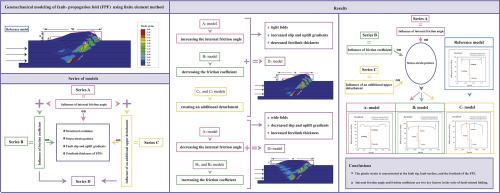Tectonophysics ( IF 2.9 ) Pub Date : 2021-07-18 , DOI: 10.1016/j.tecto.2021.228992 Anis Khalifeh-Soltani 1 , Seyed Ahmad Alavi 1 , Mohammad R. Ghassemi 2, 3 , Mehdi Ganjiani 4

|
The interplay between faulting and folding mechanisms has been recognised in extensional and contractional settings. Numerous investigations have documented that the analysis of structural aspects of fault-related folds is important for the exploration and exploitation of hydrocarbon resources and in seismic data interpretation. In this study, we used four series of 2-D elastic-plastic finite element models (A, B, C, and D) to investigate the influence of internal friction angle, friction coefficient, and an additional detachment on the fault slip and uplift gradients, stress-strain patterns, and structural evolution of fault-propagation folds (FPFs). We found that: 1) the stress-strain patterns are similar in different sections of a FPF; 2) the plastic strain is concentrated at the fault tip, fault surface, and forelimb of the FPF; 3) among the internal friction angle, friction coefficient, and additional detachment parameters, only additional detachment affects the stress-strain patterns at the crest and backlimb of the FPF; 4) to create a FPF, not only must the fault friction be less than the layers, but the layer friction also has to be less than a threshold; 5) increase in the internal friction angle, decrease in the friction coefficient, and generation of an additional detachment lead to the formation of tight folds whereas, decrease in the internal friction angle and increase in the friction coefficient create wide folds; and 6) the internal friction angle and friction coefficient are two key factors of the fault-related fold style.
中文翻译:

断层传播褶皱的地质力学建模:估计内摩擦角和摩擦系数的影响
断层和折叠机制之间的相互作用已在伸展和收缩环境中得到认可。大量调查已经证明,断层相关褶皱的构造方面的分析对于油气资源的勘探和开发以及地震数据解释非常重要。在本研究中,我们使用四个系列的二维弹塑性有限元模型(A、B、C 和 D)来研究内摩擦角、摩擦系数和附加分离对断层滑动和隆起的影响。梯度、应力应变模式和断层传播褶皱 (FPF) 的结构演化。我们发现:1)FPF 不同部分的应力-应变模式相似;2)塑性应变集中在FPF的断层尖端、断面和前肢;3)在内摩擦角、摩擦系数和附加分离参数中,只有附加分离影响FPF顶部和后肢的应力应变模式;4)要创建FPF,不仅断层摩擦力必须小于层数,而且层摩擦力也必须小于阈值;5) 内摩擦角增大,摩擦系数减小,产生额外的分离导致紧密褶皱的形成,而内摩擦角减小,摩擦系数增大,产生宽褶皱;6) 内摩擦角和摩擦系数是断层褶皱样式的两个关键因素。只有额外的分离会影响 FPF 顶部和后肢的应力应变模式;4)要创建FPF,不仅断层摩擦力必须小于层数,而且层摩擦力也必须小于阈值;5) 内摩擦角增大,摩擦系数减小,产生额外的分离导致紧密褶皱的形成,而内摩擦角减小,摩擦系数增大,产生宽褶皱;6) 内摩擦角和摩擦系数是断层褶皱样式的两个关键因素。只有额外的分离会影响 FPF 顶部和后肢的应力应变模式;4)要创建FPF,不仅断层摩擦力必须小于层数,而且层摩擦力也必须小于阈值;5) 内摩擦角增大,摩擦系数减小,产生额外的分离导致紧密褶皱的形成,而内摩擦角减小,摩擦系数增大,产生宽褶皱;6) 内摩擦角和摩擦系数是断层褶皱样式的两个关键因素。摩擦系数的降低和额外分离的产生导致紧密褶皱的形成,而内摩擦角的减小和摩擦系数的增加产生宽褶皱;6) 内摩擦角和摩擦系数是断层褶皱样式的两个关键因素。摩擦系数的降低和额外分离的产生导致紧密褶皱的形成,而内摩擦角的减小和摩擦系数的增加产生宽的褶皱;6) 内摩擦角和摩擦系数是断层褶皱样式的两个关键因素。


























 京公网安备 11010802027423号
京公网安备 11010802027423号